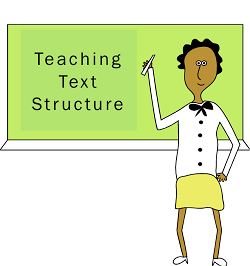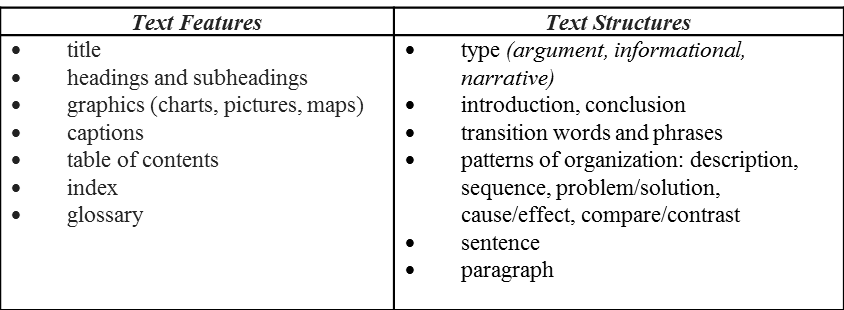Teaching Text Structures

This blog post is devoted to encouraging teachers of all grades and subject areas to teach students about text structure. It is an excellent way to improve writing and reading comprehension.
Text structure is the arrangement of ideas and the relationships among the ideas; readers and writers who are familiar with text structure recognize how the information is unfolding. Common Core Reading Standard #5 focuses on teaching text structure.
As students advance to middle and high school grades, the text that they have to read and write become increasingly varied in style, vocabulary, text structure, purpose, and intended audience.
Authors use structural elements to organize information and ideas, and to highlight important parts of the text. Text structures can be used to gain meaning when comprehending something we read, and to convey meaning when writing. Click here for a document that shows the comprehension-writing structure connection. Structural elements can be organized into two categories: text features and text structures as listed and described below.
Structural Elements
- Text features, such as title and headings, help identify the topic and overall organization of ideas. Headings represent topical sections of text, making it easier for readers to work their way through a longer piece of text in manageable “chunks.” Graphics and captions highlight important details and present an alternative representation of information to support the textual representation.
- The ability to recognize the type of writing (i.e., argument, informational, narrative) and genre allows readers to access clues about how the text is organized and presented. Introductions and conclusions help readers determine the topic and purpose of the text.
- Recognition of specific patterns of organization (e.g., sequence, compare and contrast) also supports comprehension and retention of information (Akhondi et al, 2011). Download a set of paragraph templates that can be used to help students learn how to write using different patterns of organization.
- Although it is often overlooked, the use of transition words and phrases is an important structural element. Transitions make connections among sentences, paragraphs, and larger pieces of text. Transition words and phrases often provide the reader with clues about patterns of text organization. Here is a list of common transition words.
- Knowledge of sentence and paragraph structure enables writers to develop the individual ideas within sentences (these ideas are also called propositions) and combine them to develop the main ideas in paragraphs.
Professional development for both The Key Comprehension Routine and Keys to Content Writing include suggestions for teaching text structure.
Here are some additional resources about teaching text structure:
- How to Teach Expository Text Structure to Facilitate Reading Comprehension (Akhondi, Malayeri, & Samad, 2011)
- Nonfiction Text Structures (Jen Jonson, YouTube video)
- Text Structure Worksheets (E Reading Worksheets)
- Patterns of Organization (E Reading Worksheets)
- Teaching and Assessing Understanding of Text Structures Across Grades (Karin Hess, Nat’l Center for the Improvement of Educational Assessment)
- 5 Days of Teaching Text Structure to Readers (This Reading Mama blog post)


 Joan Sedita is the founder of Keys to Literacy and author of the Keys to Literacy professional development programs. She is an experienced educator, nationally recognized speaker and teacher trainer. She has worked for over 35 years in the literacy education field and has presented to thousands of teachers and related professionals at schools, colleges, clinics, and professional conferences.
Joan Sedita is the founder of Keys to Literacy and author of the Keys to Literacy professional development programs. She is an experienced educator, nationally recognized speaker and teacher trainer. She has worked for over 35 years in the literacy education field and has presented to thousands of teachers and related professionals at schools, colleges, clinics, and professional conferences.
Leave a Reply